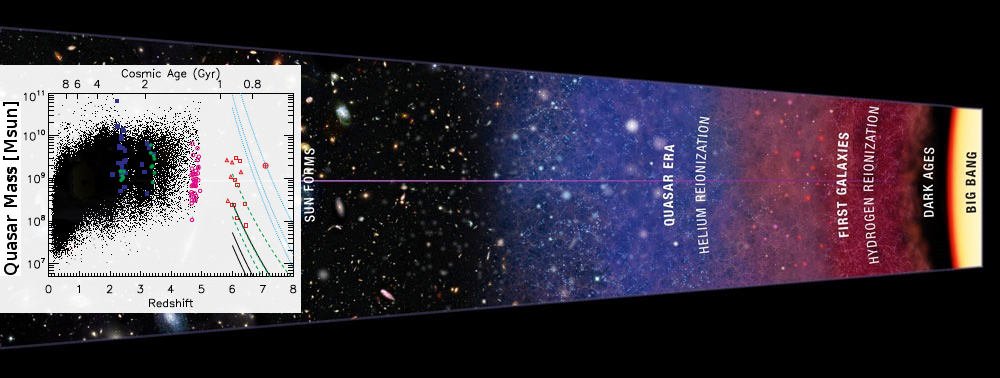Principal Investigator: Yue Shen, Carnegie Institution of Washington
Program Summary:
Recent searches for high-redshift quasars have discovered more than a hundred quasars at z>~6, and start to enable a detailed understanding of the assembly of the earliest supermassive black holes (BHs) and their hosts, one of the latest frontiers in galaxy formation studies. These impressive statistics now enable a transition from individual case studies to the more important ensemble studies of high-z quasars, and motivate novel statistical approaches that were not possible with the earlier small sample. Spectroscopy of these highest-redshift quasars contains rich information about their physical properties and provides the estimation of their BH masses using the broad emission lines. Unfortunately for these high-z quasars, near-IR spectroscopy is necessary to expand the wavelength coverage in the rest-frame UV.

A history of the Universe from the Big Bang to the present day (image credit: STScI). The inset on the left shows the collection of quasar BH masses as a function of redshift. There are currently only ~ a dozen quasars at z>~6 with measured BH masses. Our Gemini Large and Long program will increase this number dramatically, enabling a statistical study of the assembly of these earliest SMBHs at cosmic dawn.
Co-Investigators:
- Chris Willott, Canadian Astronomy Data Centre, Canada
- Ian McGreer, University of Arizona (Astronomy), USA
- Xiaohui Fan, University of Arizona (Astronomy), USA
- Michael Strauss, Princeton University (Astrophysics), USA
- Dominik Riechers, Cornell University, USA
- Fuyan Bian, Australian National University, Australia
- Luis Ho, Kavli Institute for Astronomy and Astrophysics, Peking University, China
- Linhua Jiang, Kavli Institute for Astronomy and Astrophysics, Peking University, China
- Feige Wang, Kavli Institute for Astronomy and Astrophysics, Peking University, China
- Xuebing Wu, Kavli Institute for Astronomy and Astrophysics, Peking University, China
- Marianne Vestergaard, The Niels Bohr Institute, Denmark
- Frank Bertoldi, University of Bonn, Germany
- Eduardo Banados, Max Planck Institute for Astronomy, Germany
- Bram Venemans, Max Planck Institute for Astronomy, Germany
- Fabian Walter, Max Planck Institute for Astronomy, Germany